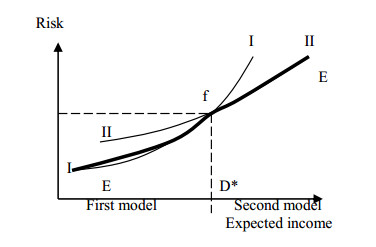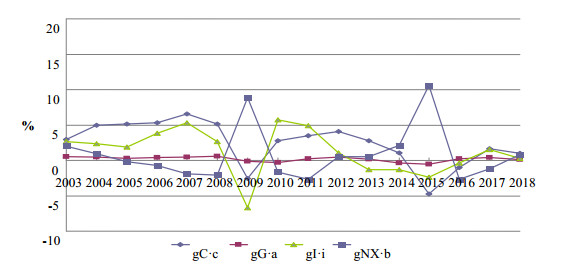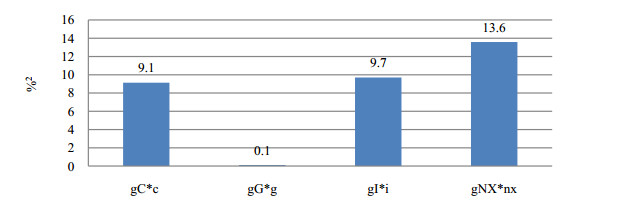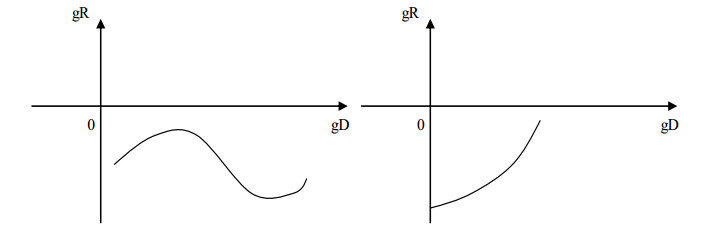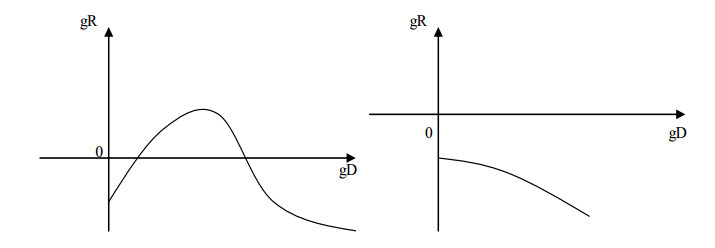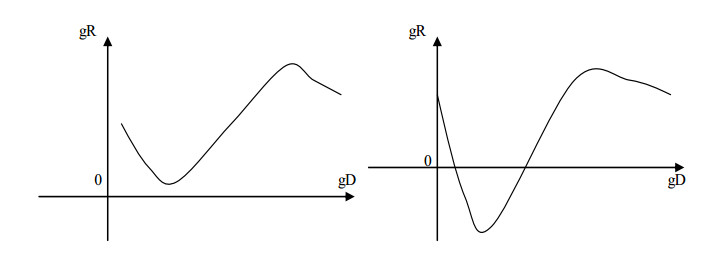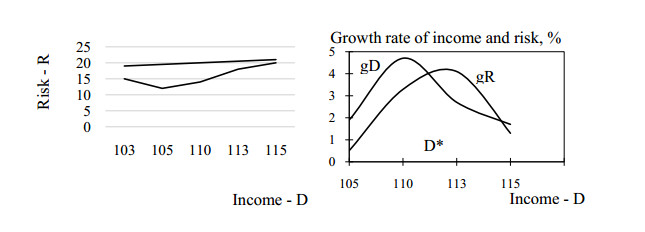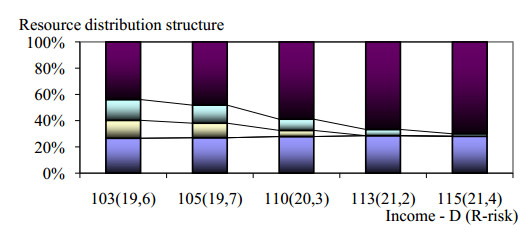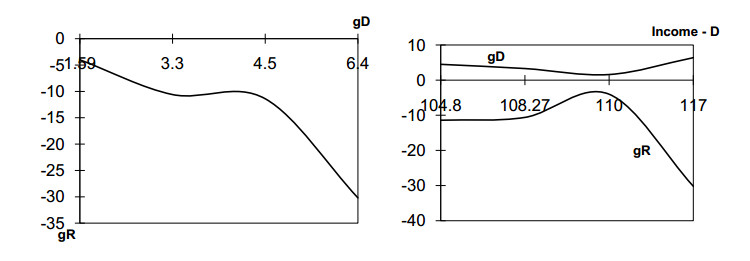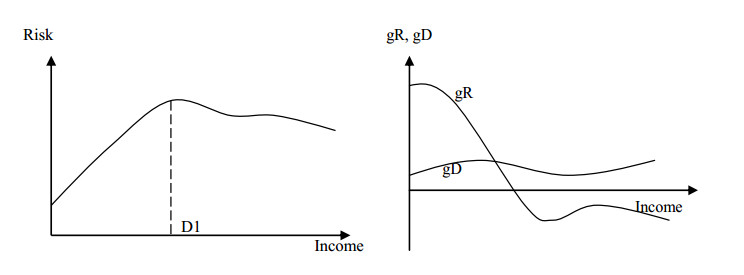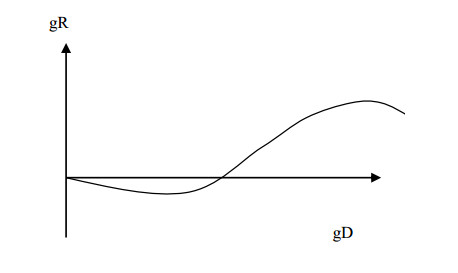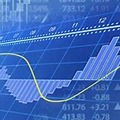The purpose of the research is to carry out the structural analysis of income and risk dynamics when considering the problem of economic growth, to obtain and apply the structural formula to assess the contribution of GDP elements to growth rate. The methodological basis of the research consists of the theory of economic growth and structural analysis, optimization methods and computer simulation (algorithmization) models of maximizing income and minimizing the total risk of N objects of the economic system. The implementation of the two stages of the research allowed us to establish that for the Russian economy the main contribution to the growth rate in the period 2003–2018 was made by gross consumption, but not by investment spending. The result of computer simulation of optimization models—maximizing income and minimizing risk is that the solution to the problem of structural choice can be an assessment of the dynamics of income and risk at a characteristic point in which different resource allocation structures give the same combination of income and risk. However, the growth rate of income and risk in the characteristic point will certainly be different, and the most acceptable option is to choose the structure that gives a positive growth rate of income and a negative growth rate of risk. This circumstance makes a significant addition to the developed macroeconomic and structural policy measures, which should be oriented not only to some static targets, but also to the impact on the dynamics of the relevant aggregated parameters—income and risk.
1.
Introduction
Structural analysis is quite a powerful tool for the study of complex relationships that arise between the economy elements, allows us to establish not only the emerging patterns, but also the impact of elements on the economy dynamics. It allows us to explore the processes of structural change occurring at different length intervals across markets, industries, sectors, allowing to study industrial processes, inequality, and even the growth impact of integration into the countries (Alonso-Carrera et al., 2018; Pi et al., 2018; Cutrini, 2019; Romano et al., 2017).
The problems of economic growth are explained by various approaches, but many of them do not take into account the impact of structural elements of the economy on growth (they do not give a structural cut of economic dynamics), but are based on the action of well-defined factors, demand, supply, the impact of technological progress, investments in R & D, trade, capital, innovation, or industry ratios for changing productivity dynamics, etc. (Gabard et al., 2017). Some researches (Zhao and Tang, 2018) consider structural changes and their impact, for example, on industry growth, the contribution of sectors to this growth, improving economic efficiency, and other works—the impact of capital accumulation and innovation on Schumpeter growth (Aghion and Howitt, 2017), where it is determined that the growth of innovation increases the capital accumulation, and a large amount of capital makes it possible for large innovators to profit. As you can see, we are talking about which of the factors has a stronger effect on the growth rate. There are studies showing the effect of structural changes on productivity growth (Erumban et al., 2019). The applied econometric models require a lot of verification effort, sometimes distort existing empirical facts on the growth of the economy, and being presented in agammaegate form does not allow us to indicate the contribution of elements of a growing economy to the overall growth rate. That is why the reason for constructing structural growth models is the goal of determining the contribution of various elements of the economy to its overall rate, and comparing the contribution to the growth rate of these elements. In addition, the structural statement of the problem is also useful because it allows one to find out how the distribution of factors and resources affects the economic dynamics. The performed structural analysis allows us to identify the dynamics mode, identify its generating element, determine the connectivity of these elements (GDP components). Factor models are required to determine the causes of such and not other dynamics, which is a different formulation of the problem and requires additional research.
In comparison with neoclassical growth theories, the evolutionary approach that provides the broader picture of growth, for example through innovation, nevertheless does not provide a current assessment of the contribution to growth of various elements of a growing economy, let alone clarify the reasons for its joint dynamics (Saviotti, 2016; Hanusch et al., 2017).
Institutional theory, which is fond of historical comparisons, is also unable to provide tools for analyzing the structural dynamics of growth (North, 1989; Aguirre, 2017; Ahmad, 2017) with the ensuing conclusions for economic policy, although it considers the impact of institutional changes on the dynamics (Davanzati, 2018). What is particularly important is how a change in the economy structure affects growth, and how it in turn leads to a change in the economic structure. In agammaegate form this process can be described by the dynamics of income and risk, and take into account the distribution of these values in the economy, which will set its structure. Therefore, the task of structural analysis of the income and risk dynamics should be reduced to elucidation of the relationship between the growth rates of income and risk, the distribution of resources between the objects of the economy. The regime of the current dynamics is likely to form a model of growth, which is required to be presented by assessing the contribution of the economy elements to the growth rate, and separately—measuring the stability of the dynamics of this contribution. This problem will be solved in this research, including the example of the Russian economy economic growth, taking into account dynamics of gross domestic product.
In connection with the above, studies on the impact of structural change on growth (Vu, 2017), economic diversification or ongoing structural reforms (Samaniego et al., 2016; Brancaccio, 2018; Freire, 2019) are widespread.
At the same time, one of the most used methods of economic growth research is structural analysis (Brondino, 2019; Sukharev, 2019). Revealing the problem of economic growth with the help of this method, it is possible to determine the contribution of the GDP component (by expenditure) to the overall rate, to give a quantitative description of the dynamics. In addition, it is possible to identify the extent to which one or the other component of GDP or sector dominates, including its contribution to the growth rate, as well as to determine the stability of this dynamics for both the individual element and the growth rate of the economic system as a whole. Thus, structural analysis allows us to explore the features of the resources distribution between sectors of the economy, to determine the mode of dynamics, for example, in relation to the growth rate of income and risk of the economy, consisting of several objects (as objects can consider, in particular, economic sectors or activities).
Below we will build models of structural dynamics and consider the possibility of using in the structural analysis of optimization models of agammaegate income and risk and also conduct a structural analysis of the contribution of GDP components to the economic growth rate (Sukharev, 2019). In contrast to the well-known approaches, mainly related to the use of econometric modeling, the structural analysis used and developed in this article allows combining the results of an empirical analysis of the GDP structure carried out according to the “structural formula” with the result of applying optimization models to solve the structural choice problem regarding resource allocation in areas of development. This is important for building sound economic growth policies. In fact, these are two independent tasks, but they are useful in terms of the formation of macroeconomic growth policies and are not taken into account in modern agammaegate econometric approaches. In any case, they are useful for verifying decisions at the level of macroeconomic policy.
Thus, the purpose of the research is to apply structural analysis to the study of the dynamics of gross domestic product, to assess the stability of this dynamics and the contribution of its components to the growth rate (by the standard deviation of the contribution of each component of GDP), as well as to obtain different modes of relationship between the growth rate of income and risk on optimization models—in the form of an independent task, demonstrating the importance and usefulness of the implementation of “structural solutions”. This approach can be further used to correct macroeconomic and structural policies in the functioning of the economies. The dynamics of income determines the dynamics of risk so that this joint dynamics forms the mode of economic development. Institutional and technological conditions, of course, have a strong impact on the current regime of such dynamics.
Let’s pay attention on the identification of dynamic relationships (between income and risk1), obtaining structural formulas to assess the contribution to the dynamics of generated income by various elements of the economy, for example, investments. The impact of investments and risks is devoted to numerous studies (Sachse, 2012; Iamsiraroj, 2016; Shinzato, 2018), however, a unified approach that would allow us to determine the contribution of investments in economic growth they do not create, nor take into account the possible correlation between income and risk. Taking into account the correlated dynamics of income and risk allows for a “structural choice” when a different resources or factors distribution gives a close combination of income and risk, and the choice of solution becomes ambiguous. In this case, it seems useful to take into account the dynamics of income and the risk of its receipt, respectively. In the framework of the theory of economic growth and growth models, this approach seems reasonable and useful. The theoretical level of solving this issue is very useful, as it will allow to use the tools to determine the weight of the factors influencing the growth and the current regime of economic dynamics determined by the associated dynamics of income and risk. To conduct the research, we formulate the following tasks to be solved within its framework: 1) we will obtain a structural formula that allows us to estimate the contribution to the growth rate of the components of GDP (gross consumption, investment and state expenditures and net exports); 2) we will analyze the relationship between the share of the GDP component and its dynamics, the contribution sustainability (on the example of the Russian economy); 3) we use models of income and risk optimization for an economy consisting of N-elements (the number of which is chosen arbitrarily for computer implementation) and analyze the ratio of the rate of change of income and risk in the resources distribution in the economy in order to demonstrate the problem of “structural choice” indicated in a previous author’s work (Sukharev, 2019).
1The risk will be assessed by the standard deviation of profit on the objects of the economy and the covariance returns.
2.
Research methodology
Investment has always been of great importance in growth models as well as in growth policies, as it symbolizes the creation of a stock base and new technologies that underpin both current and, to a greater extent, future economic growth. The structure of investments determines the nature of technological renewal. To find out the contribution of investments, as well as other components to the overall rate of economic growth, we will carry out some analytical calculations, obtaining a structural formula of2 in the form:
2The growth rate of the system is approximately equal to the sum of the multiplying the growth rate by the share of each component.
The following symbols are introduced in formula (1):
g = (1/Y) dY/dt; gc = (1/C) dC/dt; gI = (1/I) dI/dt; gG = (1/G) dG/dt; gNX = (1/NX) dNX/dt—the growth rate of the gross product and, accordingly, its components, where c = C/Y, n = I/Y, a = G/Y, b = NX/Y—for each of the components of gross domestic product (С: consumption, I: investment, G: government spendingи NX: net export) in GDP, defined by the sum of the components Y = C + I + G + NX. Differentiating the Y over time is not difficult to come to the expression (1), the so-called structural formula that allows us to analyze the contribution of components and sectors in the GDP growth rate.
Implementation of growth conditions, factors and decisions involves significant risk, but the risk differs across different growth paths. In this regard, it can be assumed that both the risk and its dynamics will also affect the growth rate of the economy. In addition, when solving the problem of resource allocation, the ratio of income and risk is important. It is this ratio that can lead to the uncertainty of structural choice, when the ratio of income and risk for various options does not allow us to choose one of them. The relationship between income and risk and the rate of its change is a relevant condition for structural choice, which will be shown in the class of optimization models used in the research (Sukharev, 2019, Ravindranetal, 1983). The initial data for the computer simulation are taken from the work (Sukharev, 2019), where the model of maximizing the total income of an economy consisting of some objects and the total risk from the resources distribution between these objects are applied. The selected time interval is considered, divided into periods, for each of which each object is characterized by return per unit of the resource invested in it (the number of objects is chosen arbitrarily).
Optimization is performed (by gradient projection method) in a static version (it is implemented below), that is, at constant values of return on the invested resource. However, optimization can be carried out for each case when the value for all objects will change at the same time intervals (or over the entire interval). Further analysis can be done by building a map of “portfolio structures” to understand how the choice will change when the returns on the considered objects of the economy, creating income with some agammaegate risk. Such calculations can be performed by iterating over the options, based on various assumptions. This method is promising.
The problem of optimization and structural analysis of the dynamics of the economy are reduced to the identification and study of the so-called characteristic points (Sukharev, 2019), which hampered the selection of the resource allocation framework (investment) in the economy.
The structural solutions are shown in Figure 1.
The final decision can be made on the amount of risk or guaranteed profit, that is, the profit received less risk and basic costs.
If the decision is made on risk (Figure 1, on the left), then the structures of distribution on the second model to the point f are the most acceptable, behind the point f at the income D > D* the choice is made on the structures obtained on the first model (EE envelope curve). When deciding on a guaranteed profit (Figure 1, on the right) to the point d the solution is satisfactory on the second model, after the point d, when R > R*, the income exceeds the value of the income of the characteristic point, the decision is made on the first model (HH envelope curve). The envelope curves of HH and HH give a range of structural choice decisions on risk and guaranteed returns. The points f and d, respectively, are the switching points of the selection structure (from one model to another). These points can be called characteristic, since it is impossible to choose a model based on the criterion of risk and guaranteed profit. The reason is the amount of risk and expected income in one case (when the decision criterion is risk), and the guaranteed profit and expected income in the other case (when the decision criterion is guaranteed profit) are the same for the first and second models. It should be noted that different distribution structures can give the same combination of risk and income. In this connection there is a problem of “structural choice”. It becomes equivalent, but from a position of considered criteria of decision-making, and at all equivalent if to enter additional qualitative criteria. Moreover, any decision in management is made in the allotted time, and quite short. Decisions are situational, although, of course, can have an impact on the dynamics in the long term. Nevertheless, they are accepted in the current regime, although they can have long-term consequences that modern science is not able to predict by and large. This applies in full measure to the adoption of the “structural solutions”, “structural choice”, which is in question here.
Characteristic points f and d may coincide, but may not coincide for the same amount of expected income. Moreover, the result, which model is the best, the risk may be one, and for guaranteed profits-another, both before and after the characteristic point (Figure 2). In addition, the characteristic point itself may be blurred. The curves are close together but do not intersect. Then it is difficult to say how to evaluate the choice, because formally the risk will not coincide for one and the other distribution structure at a given amount of expected income. Characteristic points may be absent at all, that is, the lines Ⅰ-Ⅰ and Ⅱ-Ⅱ do not intersect and do not come close to each other.
It turns out, if you compare Figure 2 and Figure 1 (right), then the second model is higher risk to the point f (was lower-Figure 1, left), and the guaranteed profit is also higher to the point d (Figure 1, right) than the first model. Behind point d in the second model is lower risk (Figure 2), but lower and guaranteed profit (Figure 1), and in the first model guaranteed profit—higher, but higher and risk. Such variants of structural dynamics, which are theoretically (and in practice) quite possible, require a non-trivial approach of determining the criterion of choice-risk or guaranteed profit, and then deciding on the structure of distribution. Should I choose a distribution that gives more guaranteed profit and more risk? The criterion of choice in this case, apparently, should take into account the difference in the guaranteed profit and risk for each model. For example, if the difference in risk is less than the difference in guaranteed profit, then you need to choose a model that gives a large amount of guaranteed profit. If the difference in risk is higher than the difference in guaranteed profit, choose the option with the least risk. Although in practice, agents can be guided purely by the indicator of guaranteed profit.
This study consists of two parts. Firstly, we carry out a structural analysis of economic growth on the example of the Russian economy in the period 2003–2018, using the structural formula (1). Secondly, we conduct a computer simulation on the models of optimization of total income (maximization model) and risk (minimization model) (Sukharev, 2019, Ravindran et al., 1983).
The model of maximizing the income of the economy from N-objects has the form:
D=∑Nj=1μj∗zj→max, provided ∑Nj=1zj≤0, zj≥0, where D—total income, zj—he value of the resource directed to the j-th object,
μj—the average return, Q—the agammaegate resource. The risk minimization model takes the following form: R=zT∗Hz→min, provided ∑Nj=1zj≤0, zj≥0, μT∗z≥D0, where H=δij2—covariance matrix for N objects, R-total risk, zj-resource value, D0-expected income value. We will use the initial data on the magnitude of returns for a randomly selected set of economic objects from the author's paper (Sukharev, 2019)
The analysis of the structural dynamics of Russia's GDP will allow to establish how the regime of structural dynamics determines economic growth and how stable the dynamics of individual components. Computer simulation will show how important it is to take into account the ratio of income growth rate and risk, especially when solving structural problems of economic development. The second stage of the study is focused on the implementation of optimization models and uses abstract quantitative estimates (without reference to the economy of Russia or another country).
3.
Structural dynamics of the Russian economy
Let’s carry out the structural analysis of economic growth on the example of the Russian economy, highlighting the contribution of each component of GDP to the growth rate (first step) and determining the stability of the dynamics of the contribution of each component to the growth rate (second step). The contribution may not be high, but the dynamics may be stable. How possible is the situation when the contribution is significant, but its dynamics is unstable. Economic growth also, depending on the sustainability of the contribution of the GDP components, can be characterized by one or another value of sustainability. An estimate of this value can be given by the mean square deviation of the contribution of each component of GDP.
The application of structural analysis to the GDP dynamics by expenditure will be shown on the example of the Russian economy in the period from 2003 to 2018. The analysis will be built on those provisions that are developed in the previous section of the article.
The calculation by the structural formula (1) reflects Figure 3. As we can see, the contribution of GDP components to the growth rate is dominated by gross consumption, investment spending occupies the second position, and its leading role is noted only in some years in the period under consideration (namely, in 2010–2011, 2017). In other years, they occupied the second, and from 2013 to 2016—the third and fourth positions in terms of contribution to the growth rate of the Russian economy.
Figures 4–5 show the relationship between the share of GDP and its rate in the 2003–2018 period.
The decrease in the gross consumption share, as can be seen from the points, is accompanied by an increase in the rate of its growth (pair correlation also shows the presence of a similar relationship, although not strong). With an increase in the government spending share, the rate of this component does not increase significantly, there is a case when the decrease in the share was accompanied for the Russian economy by an increase in the growth rate of this component of GDP. The close relationship between the share of government spending and the growth rate of this component by pair correlation is 0.46. The increase in the share of gross accumulation is accompanied by an increase in the growth rate of this component (pair correlation-0.4). The share of net exports in GDP and its rate are almost unrelated.
Having a ratio of the contribution of the GDP component and its growth rate, we can conclude how expedient it is to accelerate, say, government spending or investment so that their contribution to the total economic growth rate is the largest. As noted above, in addition to the contribution and rate of the component, it is useful to take into account how stable the dynamics of this component are. Let us evaluate the stability of the contribution of the GDP component by the standard deviation of the contribution.
Figures 6–7 show the empirical relationship between the share of government spending in GDP and its contribution to the growth rate of the Russian economy in order to demonstrate whether there was a relationship between these two parameters and how stable the structural dynamics was3.
3The stability of the structural dynamics will be assessed by the variance (spread) of the contribution of components and sectors to the growth rate (as one of the possible options).
The reason for the fluctuations in the contribution of each component of GDP indicates instability in the development of the Russian economy, when the factor conditions for growth change from year to year, which does not create stable dynamics of the contribution of the component to the overall growth rate. Deeper estimates of the causes can be clarified by factor analysis and special econometric modeling, although these methods of unambiguous reasons of precisely the fluctuations of the contribution of components to growth may not be established, since the uncertainty and variability of the modern economic dynamics of the economy in question (Russia) is too high.
The analysis of the graphs in Figures 6–7 (by points) allows us to draw the following conclusions:
Firstly, the smaller value of gross consumption (by share) corresponds to a greater contribution to the growth rate (if the share is less than 49%, with an increase in the share from 38 to 49%, the contribution of consumption to the growth rate increased);
Secondly, both a small and relatively large share of government spending in GDP, say, 17 and 23% gave about the same, and not a large contribution to the overall growth rate, no more than 0.6%, the contribution of government spending ranged from −0.5% and −0.2% to +0.2% and +0.6%;
Thirdly, both the low and high share of investment in GDP contributed roughly to the growth rate of the economy;
Fourthly, there is no close relationship between the share of net exports in GDP and the contribution to growth.
Thus, over the entire study period with a change in the component share in GDP, its contribution for each component has significant fluctuations, which clearly indicates the unstable nature of growth and high variability of growth factors. This circumstance must be taken into account when developing government measures. In other words, a strong relationship between the share of each component and its contribution to the pace is not found in the Russian economy over the specified period.
Of the 16 points of contribution of net exports, 8 represent a negative contribution (consumption—only 3 points, government spending—4, investment—5), while the connection that a greater share of net exports corresponds to a greater contribution is not found. The two points on the graph (Figure 7, right) corresponding to the contribution values of 8–10% are not indicative and do not correspond to the largest share of net exports (these are the points of 2006 and 2009).
Figure 7 on the left shows that an increase in the share of investment in GDP does not guarantee an increase in the contribution of investment to economic growth. In this regard, the policy of increasing the accumulation rate as the main condition for economic growth in Russia may not lead to the desired result of an increase in the growth rate. The effect of such an increase in the share of investments is determined by the structure of investments, as well as by the initial state of the sectors that adsorb investments in the largest volume. Especially noticeable in Figure 7 (left) is the volatility of the contribution of investments to the growth rate when their share in GDP changes. There are significant fluctuations in the contribution. Thus, the economic growth rate will be either weak or not at all sensitive to this structural change. Moreover, there may be an illusion that the growth rate increased with an increase in the share of investment in GDP, but in reality the increase in this share could occur due to a decrease in the share of gross consumption, which provided an increase in the contribution of gross consumption to the rate, and not investment. The reason for the ambiguous impact of investment on economic growth seems to be related to the way in which it is distributed in the economy—between sectors and activities, as well as between new and old technologies, thus affecting productivity and the labour market. Both of these factors are the most limiting in ensuring a particular economic dynamics, reflect structural changes.
More accurate stability assessment of the structural dynamics can be assessed by the magnitude of the standard deviation of the contribution of sectors and GDP components to the growth rate. A larger value of the standard deviation indicates a high spread of the contribution relative to the average value, a smaller one—a smaller value of the spread (respectively, a more stable situation when the deviations are low).
Figure 8 shows the standard deviation of the component contribution to the GDP growth rate of Russia for the period 2003–2018.
According to the standard deviation, the most generalized assessment of the risk contribution of GDP components to its growth is given. This parameter becomes a characteristic of structural dynamics stability.
As can be seen from Figure 8, gross consumption and capital formation for the sustainability of the contribution to the growth rate of close, while the least scatter contribution from the average value show government spending, but they made the lowest contribution to the growth rate, unlike the gross consumption and gross capital formation. This seems to be due to the predictability of budget planning and the very modest impact of government spending on economic dynamics (as can be seen in Figure 1). Not high stability of dynamics does not mean a low contribution to the pace, on the contrary, the higher the contribution, apparently, the stability of the dynamics will not be the highest.
The rate of growth of the income of the economy will certainly be associated with the risk growth rate, since the magnitude of risk and the speed of its change will change the preferences of agents. We apply optimization models to demonstrate the problem of structural choice by examining the modes of correlation between the rate of income and the risk of the economy. For computer simulation the working conditions are taken (Sukharev, 2019) and the model of income maximization and risk minimization of an economic system consisting of a certain set of objects is applied (the variant with five and six objects is considered, the value of which is set according to the author’s work). The optimization method is the gradient projection method (Ravindran et al., 1983).
4.
The ratio of income and risk dynamics in the resources distribution of a growing economy
Having undertaken a computer simulation (according to the above optimization models) we will obtain and graphically show the main results concerning the emergence of different modes of income and risk dynamics of the economy4.
4Since the relationship between income dynamics and risk is of interest, numerical expressions of rates are not so important. It uses data on objects for computer simulation from the author's article (Sukharev, 2019) on the model of income maximization and risk minimization, indicated above.
The change rate in income and risk, in addition to their values, are those dynamics parameters that can also be influenced, that is, to form economic policy measures taking into account such dynamics.
The obtained simulation results are summarized in the form of graphic material presented in the following figures.
The risk growth rate is indicated by gR, the income growth rate—gD. Figure 9 shows the income and risk growth rate by the models of income maximization and risk minimization.
The risk growth rate is negative, that is, the agammaegate risk is reduced (the rate is negative) by two models. As the income growth rate increases, the risk reduction decreases (Figure 9, right), as the negative risk growth rate decreases (that is, the growth rate increases—according to the risk minimization model).
Under the income maximization model, the negative risk growth rate decreases first, then increases, and then decreases slightly as the income growth rate increases (Figure 9, left).
According to the risk minimization model, the value of the negative risk rate is quite large and decreases (that is, the rate increases, approaching zero). For the income maximization model, the risk growth rate is negative, but the growth rate is several times smaller. The rate itself increases (negative growth rate decreases), then decreases (negative growth rate increases), so that the total amount of risk in the resulting optimization is on average higher in the income maximization model than in the risk minimization model.
In general, for this simulation, it is beneficial to stimulate the income growth rate, which is accompanied by a negative risk growth rate, that is, the risk decreases. This is the best situation for any amount of risk that needs to be lowered. Therefore, economic policy measures in this mode of economy functioning should be aimed at maintaining the current dynamics in the ratio of income and risk growth.
If the economy consists of six objects, each of which is characterized by its return on the invested unit of resource, with the same resource in 100 distributable units, the situation on the model of maximizing income will look like in Figure 10 (left), on the risk minimization model—on the right.
With the increase in the income growth rate, the risk growth rate increases, reaches positive values, that is, the risk increases significantly. Then the risk growth rate decreases and becomes negative. The amount of risk is reduced. Probably, this may be due to the fact that the sixth object appeared in the economy is associated with a large risk, which provides an increase not only in the overall value of the risk, but also its rate. Later, with the income growth rate of increase, the risk growth rate becomes negative, the risk decreases. According to the risk minimization model (Figure 10, right), the risk growth rate is negative, therefore, the amount of risk decreases, and this decrease increases, since the negative risk growth rate increases with the increase in the income growth rate (which is positive).
With computer simulation, the situation reflected in Figure 11 on the model of maximizing income (left), minimizing risk (right) is possible.
In Figure 11 (left) as the income growth rate increases, the risk growth rate throughout the time interval is positive, that is, the risk increases. First, the pace decreases slightly, then increases significantly and decreases slightly. According to the risk minimization model (Figure 11, right), the risk growth rate decreases to negative values, but with a further increase in the income growth rate again becomes positive up to the initial value. However, the total amount of risk under the risk minimization model is lower than under the income maximization model. However, the ratio of rates obtained for different initial conditions is different. This suggests that different modes of functioning of the economic system in its structural representation can be formed and rapidly change in economic reality. Different elements of the economy (objects) show different changes in risk and different dynamics of income. Of course, in practice it is necessary to look for explanations, reasons why the rates of change of these indicators are correlated in this way and not otherwise. Such a search is a spectrum of necessary additional studies that should be carried out on the example of a specific economic structure, which requires the collection of additional information, data, factor models, etc., which was not included in the objectives of this paper.
We give below modify the risk value of the income according to the model of income maximization (1) and risk minimization (2), give the change in the income and risk growth rate and the correction of the economic structure due to a change of resource allocation (Figures 12–13).
Figure 12 (left) shows that as income increases, the risk in the first model increases, in the second—first decreases, then increases almost to the same values, but remains below the risk in the first model. The income growth rate is higher and overtakes the risk growth rate to a certain amount of income D*, after which the risk growth rate is higher than the income growth rate (according to the income maximization model) (Figure 12, right). It should be noted that the risk growth rate remains positive, that is, the risk increases according to the income maximization model.
The structure of resource allocation according to the income maximization model is shown in Figure 13 (risk is shown in brackets next to the amount of income). Note that with income growth, the risk increases—the diversification level of resource allocation is clearly reduced (lower diversification—higher risk of resource allocation). As a result, the structure of two elements receives the greatest income, and this distribution corresponds to the greatest risk.
According to the risk minimization model, the ratio of growth rates is shown in Figure 14 (left), and the income and risk growth rate is shown in Figure 14 (right). As we can see, when risk is minimized, the risk growth rate is negative and this negative value of the rate increases, that is, the risk value decreases as the income growth rate increases.
As income increases, the income growth rate decreases, the risk growth rate increases but remains negative (i.e., the risk decreases), then the income growth rate increases, and the negative risk growth rate also increases (Figure 14, right).
When increasing the resource on the model of maximizing income, we have the following simulations (Figure 15).
With the increase in the amount of income, the risk also increases to some value of D1, then the risk decreases slightly, having a small area of slight increase. The risk growth rate is initially high positive, but decreases, then becomes negative, the risk is reduced. Income increases, first at an upward and then downward rate, which is positive. The risk, although reduced by the negative growth rate, is nevertheless higher than the baseline for a smaller amount of income. Thus, the income maximization model gives on average a higher risk with the amount of income that the risk minimization model. Using Figure 15, it is easy to show that as the income growth rate increases, the risk growth rate, being negative, increases in the negative area, then increases to positive values and decreases in the positive area (Figure 16).
These simulations are based on the result of optimizations for the set values of return on portfolio objects and reflect a particular scenario, based on the initial conditions of optimization.
However, the results confirm the relationship between the rate of change in the risk and income of the economic structure, represented by several elements.
Of course, the change in the value of return on the invested resource will greatly affect the resources distribution, but the distribution itself will be determined by the allocated resource, without which it is hardly possible to change this parameter relevant to the economy. Moreover, the return varies by elements, which transforms the picture of the resource distribution on the objects of the economy.
If you increase the income growth rate (positive rate) risk growth rate is mainly positive according to the model of income maximization and mostly negative—on the model of minimizing risk.
In the first case, this circumstance indicates an overall increase in risk with income growth, in the second case—a decrease in risk with income growth. Therefore, when choosing the structure of resource allocation (investments), it is necessary to focus on the structure that gives the highest income with the lowest risk, if possible, increase the rate of income growth and reduce the rate of risk growth, or seek to fix the risk growth rate in the negative values. Testing the policy methods that would lead to such an outcome is the next task (stage) of the study, which can be solved in future works.
5.
Conclusion
At the end of the article we will formulate the main results that emphasize the achievement of the goal of the study.
Firstly, the models of economic growth by contribution to the growth rate of its various elements are identified. The assessment of the current regime of its dynamics depends on the structural presentation of the final agammaegate of the economy.
Secondly, the change rate of the share and the change rate of the growth rate of the element affect the value of its contribution to the overall growth rate. Sustainable structural dynamics can be described by the value of the permissible deviation change of the input element in the growth and sustainable economic dynamics allowable deviation total growth rate from the average value (standard deviation).
Thirdly, within the framework of the constructed optimization models, which allow to demonstrate the problem of “structural choice”, different regimes of income and risk dynamics are obtained. Taking these into account, it is possible to adjust economic policy measures in order to ensure a positive rate of income growth (increase in income), while reducing the risk—a negative growth rate. In the situation of a characteristic point obtained on optimization models (numerical gradient projection method), the structural choice becomes ambiguous (Sukharev, 2019) and can be carried out by comparing the dynamics of income and risk at this point.
Then there is a need to estimate the growth rate of risk and income at a characteristic point (different distribution structures give the same income and risk), because the risk and income rate obtained for different structures at this point will certainly be different.
The structure that will give at this point a positive growth rate of income growth and a negative rate of risk growth, will be the most preferable, can be the result of “structural choice” (which was understood as the choice of the structure of the distribution of investments). If the rates of both risk and income coincide at the characteristic point, then other qualitative selection criteria will be needed, which can be the subject of consideration in subsequent studies.
Acknowledgments
This manuscript benefited from the valuable comments of two anonymous reviewers.
Conflict of interest
The author declares no conflict of interest in this paper.
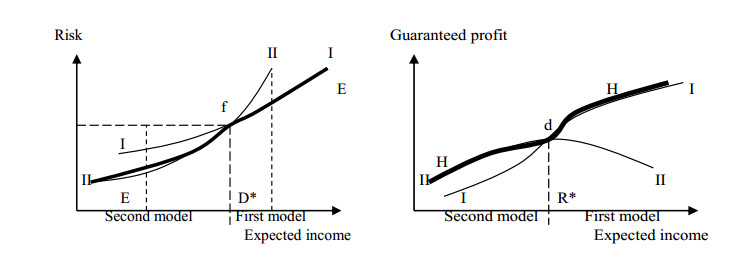









 DownLoad:
DownLoad:
